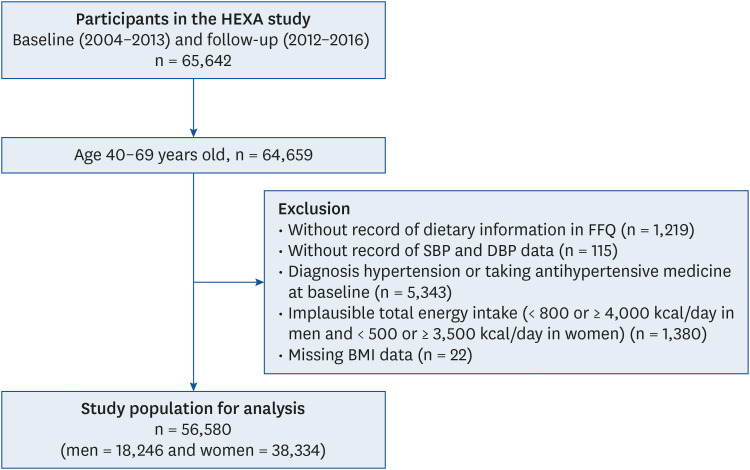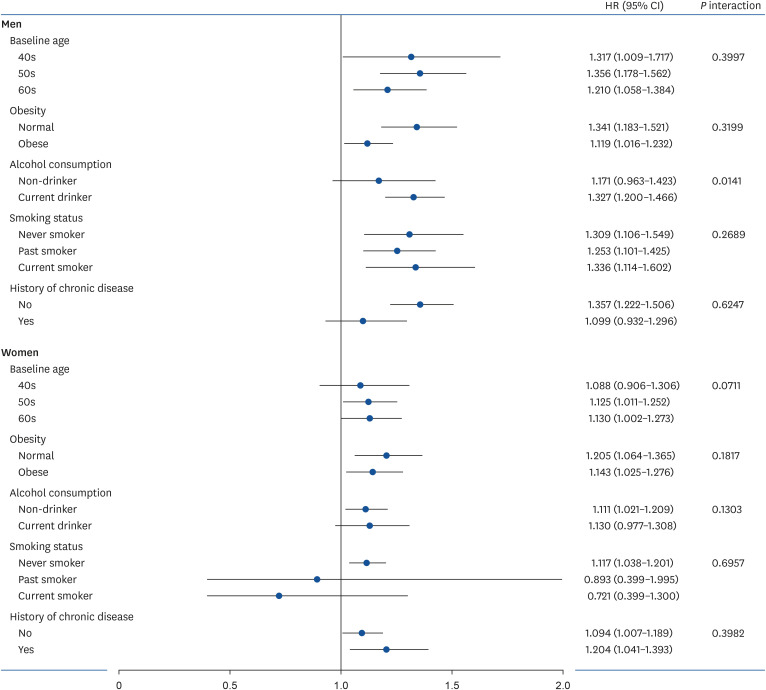Nutr Res Pract.
2024 Apr;18(2):282-293. 10.4162/nrp.2024.18.2.282.
Association of hypertension with noodle consumption among Korean adults based on the Health Examinees (HEXA) study
- Affiliations
-
- 1Department of Food and Nutrition, Chung-Ang University, Anseong 17546, Korea
- 2Division of Cancer Prevention, National Cancer Control Institute, National Cancer Center, Goyang 10408, Korea
- 3Faculty of Medicine and Health, School of Medical Science, University of Sydney, Camperdown, NSW 2006, Australia
- KMID: 2558504
- DOI: http://doi.org/10.4162/nrp.2024.18.2.282
Abstract
- BACKGROUND/OBJECTIVES
The prevalence of hypertension is increasing, and noodles have a high sodium content, so noodle consumption might be associated with a higher prevalence of hypertension. This study aimed to analyze the association between total and types of noodle intake and the risk of hypertension among Korean adults. Subjects aged 40–69 years were selected for this study.
SUBJECTS/METHODS
This study included 56,580 participants (18,246 men and 38,334 women) aged 40–69 years old from the Health Examinees study. Noodle and nutrient intakes were assessed using the food frequency questionnaire. Hypertension was diagnosed as systolic blood pressure ≥ 140 mmHg and/or diastolic blood pressure ≥ 90 mmHg or antihypertensive medication use. Cox proportional hazard models were used to calculate the hazard ratio (HR) and 95% confidence interval (CI) for hypertension.
RESULTS
Higher noodle consumption was associated with increased hypertension among men (HR, 1.273; 95% CI, 1.166–1.390) and women (HR, 1.116; 95% CI, 1.038–1.199).
CONCLUSION
We recommended reducing noodle intake and consuming vegetables and fruits to increase potassium intake, which can prevent vascular diseases.
Keyword
Figure
Reference
-
1. Kim SJ, Lee J, Jee SH, Nam CM, Chun K, Park IS, Lee SY. Cardiovascular risk factors for incident hypertension in the prehypertensive population. Epidemiol Health. 2010; 32:e2010003. PMID: 21191456.2. Kim HC, Lee H, Lee HH, Son D, Cho M, Shin S, Seo Y, Kim EJ, Ahn SV, Jee SH, et al. Korea hypertension fact sheet 2023: analysis of nationwide population-based data with a particular focus on hypertension in special populations. Clin Hypertens. 2024; 30:7. PMID: 38424634.3. Biino G, Parati G, Concas MP, Adamo M, Angius A, Vaccargiu S, Pirastu M. Environmental and genetic contribution to hypertension prevalence: data from an epidemiological survey on Sardinian genetic isolates. PLoS One. 2013; 8:e59612. PMID: 23527229.4. World Health Organization. A Global Brief on Hypertension: Silent Killer, Global Public Health Crisis: World Health Day 2013. Geneva: World Health Organization;2013.5. Chen J. Epidemiology of hypertension and chronic kidney disease in China. Curr Opin Nephrol Hypertens. 2010; 19:278–282. PMID: 20216066.6. Tsugane S. Salt, salted food intake, and risk of gastric cancer: epidemiologic evidence. Cancer Sci. 2005; 96:1–6. PMID: 15649247.7. Jeong Y, Kim ES, Lee J, Kim Y. Trends in sodium intake and major contributing food groups and dishes in Korea: the Korea National Health and Nutrition Examination Survey 2013–2017. Nutr Res Pract. 2021; 15:382–395. PMID: 34093978.8. Kim J, Kim J, Kang Y. Noodle consumption is positively associated with incident hypertension in middle-aged and older Korean women. Nutr Res Pract. 2019; 13:141–149. PMID: 30984358.9. Saito Y, Sakuma M, Narishima Y, Yoshida T, Kumagai H, Arai H. Greater consumption of noodle is associated with higher serum phosphorus levels: a cross-sectional study on healthy participants. J Clin Biochem Nutr. 2021; 68:78–85. PMID: 33536716.10. Osonoi Y, Mita T, Osonoi T, Saito M, Tamasawa A, Nakayama S, Someya Y, Ishida H, Kanazawa A, Gosho M, et al. Relationship between dietary patterns and risk factors for cardiovascular disease in patients with type 2 diabetes mellitus: a cross-sectional study. Nutr J. 2016; 15:15. PMID: 26847556.11. Health Examinees Study Group. The Health Examinees (HEXA) study: rationale, study design and baseline characteristics. Asian Pac J Cancer Prev. 2015; 16:1591–1597. PMID: 25743837.12. Kim Y, Han BG. KoGES group. Cohort profile: the Korean Genome and Epidemiology Study (KoGES) Consortium. Int J Epidemiol. 2017; 46:1350. PMID: 28938752.13. Kim SH, Choi HN, Hwang JY, Chang N, Kim WY, Chung HW, Yang YJ. Development and evaluation of a food frequency questionnaire for Vietnamese female immigrants in Korea: the Korean Genome and Epidemiology Study (KoGES). Nutr Res Pract. 2011; 5:260–265. PMID: 21779531.14. Ahn Y, Kwon E, Shim JE, Park MK, Joo Y, Kimm K, Park C, Kim DH. Validation and reproducibility of food frequency questionnaire for Korean genome epidemiologic study. Eur J Clin Nutr. 2007; 61:1435–1441. PMID: 17299477.15. National Institute of Agricultural Sciences. Korean standard food composition tables [Internet]. Wanju: National Institute of Agricultural Sciences;2016. cited 2021 April 23. Available from: http://koreanfood.rda.go.kr/eng/fctFoodSrchEng/engMain .16. Ministry of Health and Welfare, The Korean Nutrition Society. Dietary Reference Intakes for Koreans 2020. Sejong: The Korean Nutrition Society;2020.17. The Korean Society of Hypertension. Essentials of 2018 Korean society of hypertension guideline for management of hypertension [Internet]. Seoul: The Korean Society of Hypertension;2018. cited 2022 January 20. Available from: http://www.koreanhypertension.org/reference/guide?mode=read&idno=4246 .18. Seo MH, Lee WY, Kim SS, Kang JH, Kang JH, Kim KK, Kim BY, Kim YH, Kim WJ, Kim EM, et al. 2018 Korean society for the study of obesity guideline for the management of obesity in Korea. J Obes Metab Syndr. 2019; 28:40–45. PMID: 31089578.19. Huh IS, Kim H, Jo HK, Lim CS, Kim JS, Kim SJ, Kwon O, Oh B, Chang N. Instant noodle consumption is associated with cardiometabolic risk factors among college students in Seoul. Nutr Res Pract. 2017; 11:232–239. PMID: 28584580.20. Shin HJ, Cho E, Lee HJ, Fung TT, Rimm E, Rosner B, Manson JE, Wheelan K, Hu FB. Instant noodle intake and dietary patterns are associated with distinct cardiometabolic risk factors in Korea. J Nutr. 2014; 144:1247–1255. PMID: 24966409.21. Kim YY, Bae YJ, Choi MK. Sodium content and daily intake of instant noodle in Korean adolescents and adults. Trace Elem Electrolytes. 2015; 32:197–203.22. Rust P, Ekmekcioglu C. Impact of salt intake on the pathogenesis and treatment of hypertension. Adv Exp Med Biol. 2017; 956:61–84. PMID: 27757935.23. Grillo A, Salvi L, Coruzzi P, Salvi P, Parati G. Sodium intake and hypertension. Nutrients. 2019; 11:1970. PMID: 31438636.24. Kogure M, Nakamura T, Tsuchiya N, Hirata T, Nochioka K, Narita A, Hatanaka R, Itabashi F, Kanno I, Obara T, et al. Consideration of the reference value and number of measurements of the urinary sodium-to-potassium ratio based on the prevalence of untreated home hypertension: TMM cohort study. Hypertens Res. 2022; 45:866–875. PMID: 35043014.25. Kogure M, Nakaya N, Hirata T, Tsuchiya N, Nakamura T, Narita A, Suto Y, Honma Y, Sasaki H, Miyagawa K, et al. Sodium/potassium ratio change was associated with blood pressure change: possibility of population approach for sodium/potassium ratio reduction in health checkup. Hypertens Res. 2021; 44:225–231. PMID: 32801312.26. Imamura M, Sasaki H, Shinto T, Tahara Y, Makino S, Kuwahara M, Tada A, Abe N, Michie M, Shibata S. Association between Na, K, and lipid intake in each meal and blood pressure. Front Nutr. 2022; 9:853118. PMID: 35308273.27. Gonçalves C, Abreu S. Sodium and potassium intake and cardiovascular disease in older people: a systematic review. Nutrients. 2020; 12:3447. PMID: 33182820.
- Full Text Links
- Actions
-
Cited
- CITED
-
- Close
- Share
- Similar articles
-
- Dairy product consumption and type 2 diabetes among Korean adults: a prospective cohort study based on the Health Examinees (HEXA) study
- Atherogenic index of plasma and its association with food group intake in Korean adults: based on the baseline data of KoGES-HEXA study
- Noodle consumption is positively associated with incident hypertension in middle-aged and older Korean women
- Association of instant noodle intake with metabolic factors in Korea: Based on 2013~2014 Korean National Health and Nutrition Examination Survey
- Comparison of 24-hour Recalls with a Food Frequency Questionnaire in Assessing Coffee Consumption: The Health Examinees (HEXA) Study



